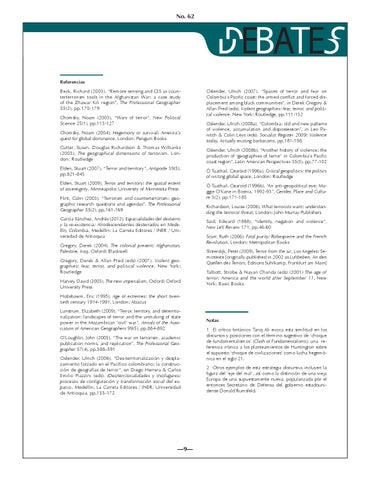No. 62
Referencias Beck, Richard (2003), “Remote sensing and GIS as counterterrorism tools in the Afghanistan War: a case study of the Zhawar Kili region”, The Professional Geographer 55(2), pp.170-179 Chomsky, Noam (2003), “Wars of terror”, New Political Science 25(1), pp.113-127 Chomsky, Noam (2004), Hegemony or survival: America’s quest for global dominance, London: Penguin Books Cutter, Susan, Douglas Richardson & Thomas Wilbanks (2003), The geographical dimensions of terrorism, London: Routledge Elden, Stuart (2007), “Terror and territory”, Antipode 39(5), pp.821-845 Elden, Stuart (2009), Terror and territory: the spatial extent of sovereignty, Minneapolis: University of Minnesota Press Flint, Colin (2003), “Terrorism and counterterrorism: geographic research questions and agendas”, The Professional Geographer 55(2), pp.161-169 García Sánchez, Andrés (2012), Espacialidades del destierro y la re-existencia: Afrodescendientes desterrados en Medellín, Colombia, Medellín: La Carreta Editores / INER / Universidad de Antioquia Gregory, Derek (2004), The colonial present: Afghanistan, Palestine, Iraq, Oxford: Blackwell Gregory, Derek & Allan Pred (eds) (2007), Violent geographies: fear, terror, and political violence, New York: Routledge Harvey, David (2003), The new imperialism, Oxford: Oxford University Press
Oslender, Ulrich (2007), “Spaces of terror and fear on Colombia’s Pacific coast: the armed conflict and forced displacement among black communities”, in Derek Gregory & Allan Pred (eds), Violent geographies: fear, terror, and political violence, New York: Routledge, pp.111-132 Oslender, Ulrich (2008a), “Colombia: old and new patterns of violence, accumulation and dispossession”, in Leo Panitch & Colin Leys (eds), Socialist Register 2009: Violence today. Actually existing barbarisms, pp.181-198 Oslender, Ulrich (2008b), “Another history of violence: the production of ‘geographies of terror’ in Colombia’s Pacific coast region”, Latin American Perspectives 35(5), pp.77-102 Ó Tuathail, Gearóid (1996a), Critical geopolitics: the politics of writing global space, London: Routledge Ó Tuathail, Gearoíd (1996b), “An anti-geopolitical eye: Maggie O’Kane in Bosnia, 1992-93”, Gender, Place and Culture 3(2), pp.171-185 Richardson, Louise (2006), What terrorists want: understanding the terrorist threat, London: John Murray Publishers Said, Edward (1988), “Identity, negation and violence”, New Left Review 171, pp.46-60 Scurr, Ruth (2006), Fatal purity: Robespierre and the French Revolution, London: Metropolitan Books Sloterdijk, Peter (2009), Terror from the air, Los Angeles: Semiotexte [originally published in 2002 as Luftbeben. An den Quellen des Terrors, Editions Suhrkamp, Frankfurt am Main] Talbott, Strobe & Nayan Chanda (eds) (2001) The age of terror: America and the world after September 11, New York: Basic Books
Hobsbawm, Eric (1995), Age of extremes: the short twentieth century 1914-1991, London: Abacus Lunstrum, Elizabeth (2009), “Terror, territory, and deterritorialization: landscapes of terror and the unmaking of state power in the Mozambican ‘civil’ war”, Annals of the Association of American Geographers 99(5), pp.884-892 O’Loughlin, John (2005), “The war on terrorism, academic publication norms, and replication”, The Professional Geographer 57(4), pp.588–591 Oslender, Ulrich (2006), “Des-territorialización y desplazamiento forzado en el Pacífico colombiano: la construcción de geografías de terror”, en Diego Herrera & Carlos Emilio Piazzini (eds), (Des)territorialidades y (no)lugares: procesos de configuración y transformación social del espacio, Medellín: La Carreta Editores / INER, Universidad de Antioquia, pp.155-172
—9—
Notas 1 El crítico británico Tariq Ali evoca esta similitud en los discursos y posiciones con el término sugestivo de ‘choque de fundamentalismos’ (Clash of Fundamentalisms), una referencia irónica a los planteamientos de Huntington sobre el supuesto ‘choque de civilizaciones’ como lucha hegemónica en el siglo 21. 2 Otros ejemplos de esta estrategia discursiva incluyen la figura del ‘eje del mal’, así como la distinción de una vieja Europa de una supuestamente nueva, popularizada por el entonces Secretario de Defensa del gobierno estadounidense Donald Rumsfeld.
